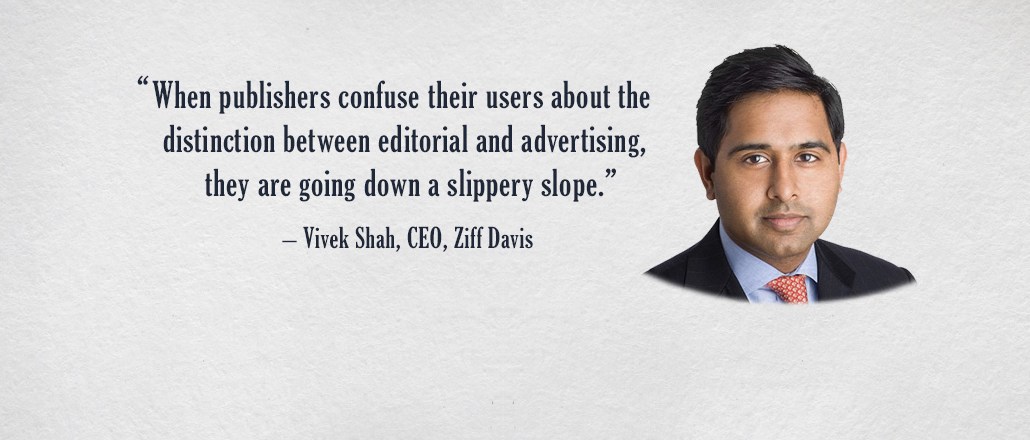Insights from CTV leaders at Dentsu, Horizon Media and more

Few turnarounds are as unlikely as the one Ziff Davis managed to pull off.
The 88-year-old publisher of a stable of business-to-business and print titles struggled with the shift to the Internet, which upended the value position of its tech brands. There wasn’t much hope for the company, owner of PCMag, AskMen and IGN. It filed for bankruptcy protection in 2008.
Fast forward to now, and Ziff Davis’ prospects look very different. While Ziff Davis is still a publisher in the traditional sense, it has also bet the farm on ad tech, data and a heavy focus on performance marketing. The result: Ziff Davis’ earnings climbed from a paltry $1.6 million in 2010 to $53 million in 2014 on revenues of $170 million, according to CEO Vivek Shah, the former Time Inc. executive who helped architect the turnaround after joining in 2010.
In Digiday’s latest installment of Executive Summary, featuring conversations with publishing company heads, we spoke to Shah about the staying power of Ziff Davis, the problem with scale, and why he isn’t crazy about how some publishers label their sponsored content.
Ziff Davis has gone through so many forms and was in such bad shape that I’m surprised you took a stab at rescuing it. How do you explain its staying power?
The company has been through a number of incarnations, but it’s always been vertically focused and has always been oriented toward helping users with purchase decisions. It’s a powerful formula as you’re able to deliver valuable audiences with strong intent.
That intent idea is core to the Ziff Davis commerce business.
Consumers love a deal. We have a dedicated team that secures and identifies discounts for our audiences. So it goes beyond just integrating a click-to-buy but to also delivering a deal that gets the user to check out immediately.
What do you think of the buy-button push from the likes of Instagram, Pinterest and Twitter? Does it make sense to you?
It makes total sense and will fuel the continuing shift from brick-and-mortar to e-commerce. It will be particularly effective for sites and apps that are already part of the consumer’s purchase journey. Sites that help users discover and choose products will be pretty successful.
Ziff Davis was an early example of a publisher that built out its own trading desk. Five years later, that’s still rare among publishers. Theories?
For some, I suspect it’s a technology and skill-set issue as operating a trading desk is fundamentally different from operating websites. For others, it may feel antithetical to what they do as publishers, which is monetizing their own inventory versus those of others. We obviously view our trading operation as complementary to our publishing business.
Publishers seem keen on either the brand-driven side or the performance-driven side. How did you manage to pull off both?
The truth of the matter is that we resemble marketers themselves who have both brand and direct-response goals. We just reflect the needs of our clients.
One thing you’re not really doing is native advertising. Is that not something you’re crazy about?
We love to market advertiser content as well as develop creative ways to present sponsorships. And, in those cases, it’s clear what’s editorial vs. advertorial. But when publishers seek to confuse their users about that distinction, I think they are going down a slippery slope.
Scale is a hot topic these days, especially when it comes to tech sites like Recode and GigaOm, which found they couldn’t compete with the bigger players. Is scale enough anymore?
Scale matters a great deal in a market in which buyers want to consolidate their budgets with fewer sellers in order to simplify and extract as much value. But beyond scale you also need a breadth of offerings — display, video, data, trading, performance — to effectively compete.
As the chair of the IAB, are you seeing the viewability debate change at all? Has it been worth the trouble?
I believe vCPM — charging for only viewable ads — will be a significant opportunity for publishers and advertisers. We’ll literally double the value of advertiser buys, which will give them the motivation to pay appropriate prices. It’s now clear that the sheer volume of non-viewable and fraudulent impressions had an unnatural deflationary effect on CPMs.
Is it hard to convince agencies that viewable inventory should be priced higher?
It’s early days, but I believe agencies understand that if you double the value of an ad campaign by eliminating the non-viewable ads, then that will be reflected in some fashion in the price.
More in Media

Ad Tech Briefing: The ‘plumbers’ posing as the unlikely saviors of the internet
After several false dawns, can Cloudflare’s ‘anti-AI scraping tool’ finally offer publishers a road to commercial redemption?

Generative AI, not ad tech, is the new antitrust battleground for Google
Global regulatory scrutiny is shifting from Google’s ad tech and search dominance to generative AI, as they aim to address the most pressing threats to publisher business models.

Yahoo takes cues from platforms as it offers more editorial control to creators
Through its creator program, Yahoo is evolving from its roots as a content aggregator and editorial publisher to more of a distribution platform for individual creators.





